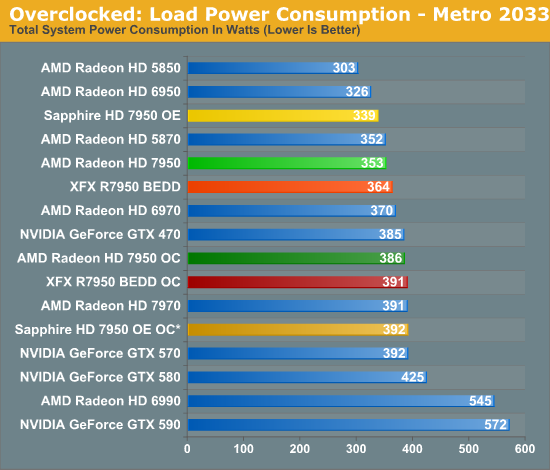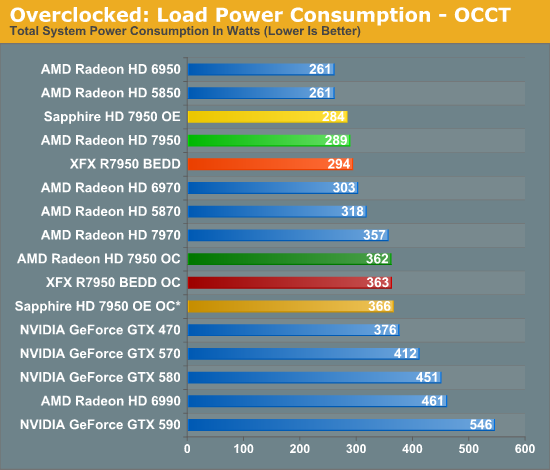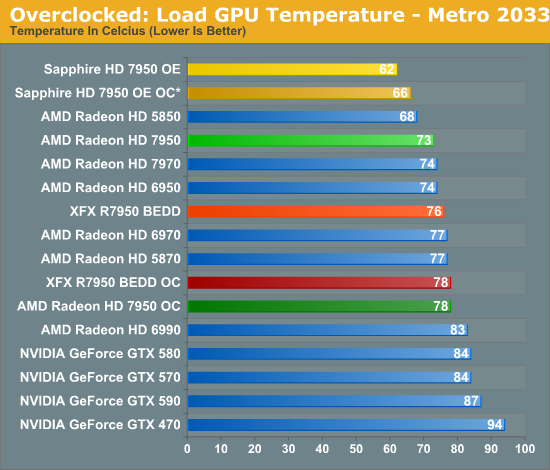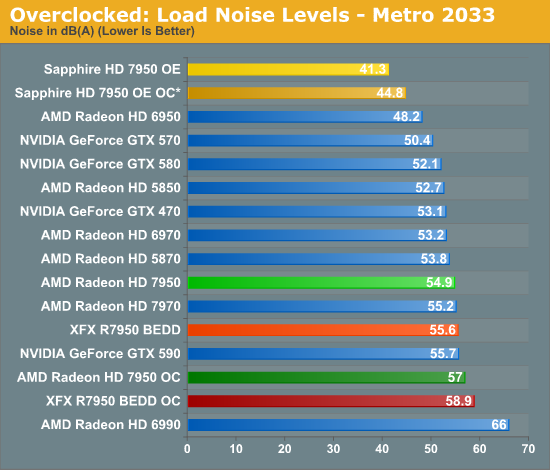AMD Radeon HD 7950 Review Feat. Sapphire & XFX: Sewing Up The High-End Market
by Ryan Smith on January 31, 2012 9:02 AM ESTOverclocking: Power, Temp, & Noise
In their marketing materials AMD is heavily pushing overclocking, and they have good reason to. With the 7970 we’ve established that Tahiti has quite a bit of overclocking headroom, and as the 7950 is clocked lower by default this opens up that headroom even further. Realistically AMD’s binning process means that the best clocking Tahiti GPUs are going to be allocated to the 7970 unless they have failed shaders, but even with that there’s quite a bit of potential on paper.
As with overclocking the 7970, our goal overclocking the 7950 is to see how much you can get for free; that is without any voltage adjustments. AMD’s reference PCBs are not particularly overbuilt for overclocking—cards like that will come later—so sticking to the reference voltage is the safest option, not to mention the easiest. With the 7970 we were able to get 200MHz (22%) overclocks without any voltage adjustment, and we’re hoping for the same out of the 7950.
With that said, we quickly ran into a wall on one card: the Sapphire 7950. Sapphire’s low VID of 0.993v may be great for temperature and noise at stock, but it’s not doing overclocking any favors. We only hit 950MHz at that voltage. As the Sapphire was the odd man out—every other card was at 1.093v—we did end up overvolting the Sapphire to 1.093v to see what it was capable of when put on similar footing as the rest of our cards.
After bringing up the voltage of our Sapphire card, all of our 7950s ended up overclocking to very similar levels. Our Sapphire and AMD cards topped out at 1025MHz core, a 225MHz (28%) overclock over a stock 7950 and a 125MHz (14%) overclock over the Sapphire’s factory overclock, while our XFX card reached 1050MHz, a 150MHz (17%) overclock beyond XFX’s factory overclock. Meanwhile the memory clocks on all of our cards topped out at 5.8GHz, beyond which we’d start seeing performance regressions from error correction on the memory bus.
| Radeon HD 7950 Overclocking | |||||
| AMD Radeon HD 7950 | Sapphire HD 7950 Overclock Edition | XFX R7950 BEDD | |||
| Shipping Core Clock | 800MHz | 900MHz | 900MHz | ||
| Shipping Memory Clock | 5GHz | 5GHz | 5.5GHz | ||
| Shipping Voltage | 1.093v | 0.993v | 1.093v | ||
| Overclock Core Clock | 1025MHz | 1025MHz | 1050MHz | ||
| Overclock Memory Clock | 5.8GHz | 5.8GHz | 5.8GHz | ||
| Overclock Voltage | 1.093v | 1.093v | 1.093v | ||
As you can imagine, with such similar overclocks, gaming performance on all 4 cards ended up being very similar. So we’ll get to gaming performance in a minute, while we’ll start with power, temperature, & noise.


Even though we’re not increasing the voltage on our AMD and XFX cards, merely overclocking them and raising the PowerTune limit to avoid throttling does drive the power consumption up. As is typical with heavily overclocked cards, overclocking quickly drives up power consumption and the 7950s are no exception. After overclocking power consumption is almost identical to the stock 7970, so while you can get 7970 performance you still need to pay the price with 7970 power consumption. Meanwhile it’s interesting to note that even with the extra 0.1v we’ve given the Sapphire card its final power consumption is only ever so slightly higher than the other 7950s, proving that voltage is the great equalizer in this case.


With the increase in power comes an increase in temperatures. The Sapphire card still does very well here staying in the low 70s even under OCCT, while the reference and XFX cards hit the high 70s under Metro and mid 80s under OCCT. As we’ve yet to really ascertain what the thermal limits are for Tahiti, it’s not clear whether there’s too much thermal headroom left for the GPU, particularly under OCCT.


Last but not least we have load noise. The Sapphire card is once more a stellar performer, and we still can’t get it above 50dB even with OCCT. Unfortunately the XFX 7950 BEDD has its biggest fallout yet—it may be able to overclock well, but at 64dB under OCCT the performance isn’t going to be worth the immense amount of noise it creates to move enough air to keep the GPU cool.










259 Comments
View All Comments
SlyNine - Tuesday, January 31, 2012 - link
I think it's you that has been sleeping. You're comparing EBay prices for god sakes. We are talking about new releases.The 5870 released 2 1/2 years ago at 379$. It was 2x as fast as the 4870.
When the 4870 released it cost what, 300$ in mid 2008. It was over 2x as fast as the 3870.
How about the amazing 9700pro at around 400$, In some cases being 4X faster then the 4600TI.
This is perhaps a step up from the to the likes of the 2900XT or 5800ultra. But both of those had some rocking competition to deal with. Like the 8800GTX and the 9700pro.
If you think this 30% better performance is worth 580$ then you have no concept of value.
Phate- - Tuesday, January 31, 2012 - link
It took you long enough to notice. Better to go and have this discussion in the comments of the HD6970 review.Galidou - Tuesday, January 31, 2012 - link
Because it's next gen, performs better for the same price and overclocks probably WAY better plus maybe a chance to mod it to 7970? Is that enough?SlyNine - Tuesday, January 31, 2012 - link
Its not better performance for the same price. This time the price has scaled with performance.Normally when a new GPU gen releases its much better performance at the same price as the previous kings release.
Look at the 9700pro, 8800GTX, 5870. Those were great cards for the time. The 7970 is just, Eh. Not bad enough to be considered a 2900XT or a 5800 Ultra. But at least those 2 cards had much better competition.
bhima - Tuesday, January 31, 2012 - link
Actually, AMD's prices for these cards are SO bad, most people will just wait or buy older tech. Hell at least Intel's Sandy Bridge i5-2500K came out at a reasonable $215 which really isn't that high for the performance you get from it... in fact, there is no other CPU at the same price that even comes close, nor was there a CPU last year for the same price that even comes close. Here, AMD is pricing themselves out of the market.mdlam - Tuesday, January 31, 2012 - link
Right, and their egregious pricing mistake is why all their cards are selling out since launch. Because all of AMD's business MBA's and experts are no match for your idea of "a good deal"Maybe you've noticed that things are usually more expensive at launch because of hype, and the fact that you have the fastest card makes pricing irrelevant. Well hell whatever, you didn't even notice that Sandy bridge 2500k opened up at $260-270 dollars at launch, what's the point in taking this further.
Dribble - Tuesday, January 31, 2012 - link
I noticed that when the 5870 and 5850 came out they blew away the competition and were relatively cheap. What was the 5850 price when it came out - about half of the 7950? Yet the performance leap over previous gen for 5850 was much larger then for 7950. That's why everyone is a bit disappointed.gibsnium - Tuesday, January 31, 2012 - link
The 2500k launched that the same price it is today; bought one from newegg at 219$ at launch.
Master_shake_ - Tuesday, January 31, 2012 - link
doesn't anyone else remember when the 8800 ultra was released and Nvidia threw a thousand dollar price tag on it???how short are your memories??
mdlam - Tuesday, January 31, 2012 - link
I remember it can barely run crysis